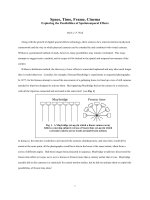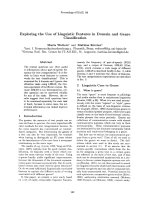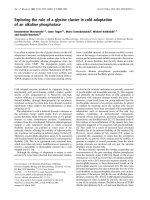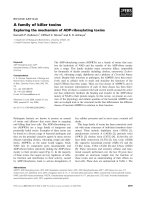Exploring the culture of an online brand community a study of a korean apple macbook user community
Bạn đang xem bản rút gọn của tài liệu. Xem và tải ngay bản đầy đủ của tài liệu tại đây (766.47 KB, 93 trang )
Exploring the culture of an online brand community:
A study of a Korean Apple MacBook user community
KIM GYEONGMIN
NATIONAL UNIVERSITY OF SINGAPORE
2010
Exploring the culture of an online brand community:
A study of a Korean Apple MacBook user community
KIM GYEONGMIN
A THESIS SUBMITTED
FOR THE DEGREE OF MASTER OF ARTS
COMMUNICATIONS AND NEW MEDIA
PROGRAMME
NATIONAL UNIVERSITY OF SINGAPORE
2010
i
ACKNOWLEDGEMENTS
I gratefully acknowledge the help of my supervisor, Dr. Cho Hichang. He
provided me with tireless supervision, valuable guidance, and important
suggestions throughout the course of the graduate program. I would also like
to express my gratitude to Dr. Milagros Rivera and numerous other faculty
members and friends on the CNM Programme. Finally, a special thanks goes
to Carol.
ii
TABLE OF CONTENTS
ACKNOWLEDGMENTS ...................................................................................... ⅰ
SUMMARY ............................................................................................................. ⅲ
LIST OF FIGURES ................................................................................................ ⅳ
CHAPTER ONE: INTRODUCTION ..................................................................... 1
Study Context: The Apple MacBook Brand ........................................................... 2
Objectives of the study............................................................................................ 4
CHAPTER TWO: LITERATURE REVIEW ........................................................ 6
Brand community.................................................................................................... 6
Online community and the online brand community ............................................. 9
eWOM and the online brand community.............................................................. 13
Symbolic interactions with the brand ................................................................... 16
Korean consumption culture ................................................................................. 20
Goffman’s dramaturgy framework ....................................................................... 22
Goffman and CMC ............................................................................................... 27
Research questions ................................................................................................ 30
CHAPTER THREE: METHOD ........................................................................... 33
Netnograpgy.......................................................................................................... 33
Selection of the netnographic community ............................................................ 35
CHAPTER FOUR: FINDINGS ............................................................................. 38
Self-portrait with the brand ................................................................................... 38
Aesthetic and distinctive objects ........................................................................... 42
Embracing Windows ............................................................................................. 51
Ritual building ...................................................................................................... 53
Coordination ......................................................................................................... 58
Restriction ............................................................................................................. 61
CHAPTER FIVE: DISCUSSION AND CONCLUSION .................................... 66
Self-representative brand photos........................................................................... 66
Brand meaning-making and reshaping ................................................................. 68
Cultural capital in the online brand community ................................................... 72
Consumers’ symbolic interactions and community rituals ................................... 74
Limitations and Suggestions for Future Research ................................................ 77
Conclusion ............................................................................................................ 78
BIBLOGRAPHY..................................................................................................... 80
iii
SUMMARY
Consumers have formed numerous brand-related and consumer
communities in computer-mediated environments (CMEs). Members of these
communities increasingly participate in brand-related communication. They
have become more active than traditional consumers in the mass media
environment and have built a culture in cyberspace.
This thesis aims to improve our understanding of Korean Apple
MacBook consumer culture in an online brand community. Based on a
consumer-centric approach, Goffman’s dramaturgy framework is used to
examine consumers’ self-presentation performance and interactions within the
community. Netnography, an ethnographical research method applicable to
CMEs, is used for the study. The findings show that Korean Apple MacBook
consumers present themselves, and interact with other members, by posting
representative brand photos and stories about their everyday lives. In doing so,
they fabricate brand meanings and create positive face. The members’ brand
meaning-making efforts construct symbolic meanings as aesthetic and
distinctive objects. Furthermore, their interactions around the brand portrait
photo construct an idealized brand consumption style. These consumers’
brand-related interactive communication produces good taste as a form of
cultural and social capital to influence members’ standing within the
community. In addition, they build community rituals – coordination,
community terms, and restrictions – to preserve the community’s identity
through its members’ communal interactions.
iv
LIST OF FIGURES
Figure 1.
In my office .................................................................................... 40
Figure 2.
In my work room............................................................................ 41
Figure 3.
Spending calming weekdays in a café with my Mac ..................... 44
Figure 4.
My Rarebody in a vintage café ...................................................... 45
Figure 5.
On a cool day, my room ................................................................. 47
Figure 6.
After adopting my doggy Mac ....................................................... 49
Figure 7.
Box stand for Mac .......................................................................... 50
Figure 8.
Mac vs. Windows arguments ......................................................... 54
Figure 9.
Trying to put an MBA in a paper bag ............................................ 57
Figure 10.
Consumers’ creative works ............................................................ 59
Figure 11.
This is my screenshot ..................................................................... 60
Figure 12.
Missing Roh ................................................................................... 64
1
CHAPTER ONE: INTRODUCTION
The rapid diffusion of the Internet has led to many dramatic changes in
people’s lives. One of the more important of these has been the proliferation of
a variety of types of online communities. With the development of information
and communication media technologies, consumers are also becoming a part
of online communities, and have formed numerous brand-related and
consumer communities online. Users increasingly participate in the creation of
marketing and brand-related communication. As such, they have become
active creators of communal and brand identities in computer-mediated
environments (CMEs). The Internet has great potential for the creation of
brand communities which are primarily defined by their participants. This
gives consumers a great deal of power in forming brand meanings (Muniz &
Shau, 2007).
A varied academic literature has emerged to study consumers’ behavior
in such online brand communities. Previous research suggests it can lead to
supportive and creative brand consumption experiences online (Kozinets,
2001, 2002; Muniz & Shau, 2007; Avery, 2007; Huang, 2008). For instance,
members of Apple brand communities have high brand loyalty: they have a
cult-like culture and the brand almost comes to mean a form of religiosity to
the consumers (Belk & Tumbat, 2005; Muniz & Shau, 2007). However, most
academic studies of the Apple brand community have focused on US
consumers, even though brand consumption styles vary across different social
contexts. For example, a global brand such as Starbucks has localized
meanings. In the Chinese local market, this iconic, global brand is transformed
2
through young urban consumers’ enactment of personally meaningful
experiences, roles, and identities in the settings of the coffee shops
(Venkatraman & Nelson, 2008). Local consumers interpret and appropriate the
meanings of global brands to their own culture (Ger & Belk, 1996).
Accordingly, we might expect a global brand like Apple to be consumed in a
different way by Koreans. However, there have been few attempts to examine
Korean Apple users’ experiences of online brand communities. Thus, this
study uses a Korean MacBook user community to understand Korean Apple
consumer culture and the meanings of the brand in the local context.
Exploring members’ self-presentation performance and their interactive
communication enables an examination of the MacBook brand meanings
being created in the Korean context. However, before examining this online
community, it is first necessary to understand the Apple MacBook brand.
Study Context: The Apple MacBook Brand
In 2010, Wikipedia provided the following description of the MacBook
brand:
The Macintosh, or Mac, is a series of lines of personal computers (PCs)
designed, developed, and marketed by Apple Inc. The first Mac was
introduced on January 24, 1984 and was the first commercially
successful PC to feature a mouse and graphical user interface (GUI)
rather than a command-line interface. Throughout the second half of the
1980s, the company built market share, only to see it dissipate in the
1990s as the PC market shifted towards IBM-PC compatible machines
running MS-DOS and Microsoft Windows. Apple consolidated its
3
multiple consumer-level desktop models into the 1998 iMac all-in-one,
which was a commercial success and revitalized the Mac brand.
Current Mac systems are mainly targeted at the home, education, and
creative professional markets. They comprise the iMac and the entrylevel Mac mini desktop models; the workstation-level Mac Pro tower;
the MacBook, MacBook Air, and MacBook Pro laptops; and the Xserve
server. Apple embarked upon the Intel era in 2006. The MacBook is the
first Mac notebook to use an Intel processor. The release of Intel-based
Mac computers introduced the potential to run native Windows-based
operating systems on Apple hardware without the need for emulation
software such as Virtual PC. The MacBook uses an operating system
(OS) called Boot Camp, which can convert Windows OS from
Microsoft to work with Apple products. This is expected to attract a
substantial number of notebook PC users to switch to Mac (“MacBook,”
2010).
To popularize the MacBook, Apple Korea introduced it as a low-priced
Mac notebook costing around 1.1 million won in June 2006. The inexpensive
and Windows OS compatible MacBook is a competitive product which can go
up against other notebooks and PCs (Kim, 2006).
As indicated above, Apple MacBook has the potential not only to
increase the number of consumers but also to extend the meaning of the Mac
brand. Historically, it has been considered a tool for a small group of
professionals. However, the computer user environment in Korea has not been
favorable to Mac users. Most Korean Internet Web sites are set up for PC users
4
only, and government and bank Web sites only service users of Internet
Explorer. This study examines how Korean MacBook consumers experience
the brand and create its meanings, by studying a Korean MacBook brand
community.
Objectives of the Study
In theoretical terms, this research takes a consumer-centric perspective
to examine the consumption experience and the meaning-making of
possessions in everyday life. People are what they possess and live with. They
continuously present themselves using their branded possessions. Through
MacBook consumers’ self-presentation acts and interpersonal communications
with each other, brand meanings can be constructed. Under this assumption,
this study uses Goffman’s dramaturgy framework to examine consumer
behavior and interaction in a particular brand community. Goffman (1959)
suggests that individuals perform as actors in social interactions. His
dramaturgical perspective is relevant to examining interpersonal
communication in an online community. Using Goffman’s framework, the
self-presentation of a group of Korean MacBook users, and their interaction in
an online brand community, will be explored. Furthermore, the Apple
MacBook brand meanings thus fabricated will be revealed by detailing the
consumers’ interactions in the brand community setting. The thesis is designed
to generate an understanding of Korean Apple MacBook consumer culture by
pursuing three goals: 1) To understand consumer self-presentation behavior in
the online brand community; 2) To understand consumer interaction in the
community; and 3) To understand how Korean consumers make meaning
5
around the Apple MacBook brand.
This research will reveal Korean MacBook users’ self-presentation
strategies and their interactive performance in an online community and
examine how they fabricate brand meanings. This will embed the global Apple
brand meanings in a local market, Korea. Through this approach, a bridge will
be built between communication research, based on Goffman’s theory, and
marketing literature on consumer and brand culture in CMEs.
Methodologically, this study employs the concept of netnography
(Kozinetz, 2002), which can be described as the adaptation of ethnographic
research techniques for the study of the culture of communities emerging
through computer-mediated communication (CMC).
6
CHAPTER TWO: LITERATURE REVIEW
Brand community
A community is “a network of social relations marked by mutuality and
emotional bonds” (Bender, 1978, p. 145). This concept is consistent with the
social network perspective of community (Wellman, 1979), and the imagined
community (Anderson, 1983). Anderson (1983) indicates that the imagined
community is formed by one’s feeling of belonging and how one imagines
being a part of it. This symbolic scope emphasizes substance over form.
Cohen (1985) states that a community is symbolically constructed as a
conglomeration of normative codes and values that provides its members with
a sense of identity.
Brand communities are a special form of community built around
brands. Muniz and O’Guinn (2001, p. 412) define such a group as a
“specialized, non-geographically bound community based on a social relations
among admirers of a brand.” It is marked by a consciousness of kind, shared
rituals and traditions, and a sense of moral responsibility (Muniz & O’Guinn,
2001). A consciousness of kind is the feeling of “we-ness,” bonding the
members, and the collective sense of difference from others not in the
community. Shared rituals and traditions can be continued in the community's
common history and culture, creating conventions for a harmonious
community. Certain behavioral norms and values are regarded as traditions. A
sense of moral responsibility denotes a sense of duty and obligation to the
community. With these common features, brand communities form specific
brand meanings and cultures through communal acts, and also function
7
actively to interpret and negotiate brand meaning in social contexts.
Consumer-centric research on brand communities is termed consumer
culture theory (Arnould & Thompson, 2005). Here, it is asserted that
“consumers build feelings of social solidarity, fragmentary, self-selected, and
transient cultural worlds through the pursuit of common consumption
interests” (Arnould &Thompson, 2005, p. 873).These social gatherings around
a common consumption interest have been studied by numerous marketing
researchers, who identify the consumer-centric consumption view as a
subculture of consumption (Kates, 2002; Mark, Richard, & Sue, 1996;
Schouten & McAlexander, 1995), a consumption world (Holt, 1995), a
consumption microculture (Thompson & Troester, 2002), or a culture of
consumption (Kozinets, 2001)
Maffesoli’s (1996) ideas on neotribalism provide a foundation for the
genre of consumer culture theory. Maffesoli (1996) argues that
the forces of globalization and postindustrial socioeconomic
transformation have significantly eroded the traditional bases of sociality.
Moreover, globalization has also encouraged a central ethos of radical
individualism, oriented around a ceaseless quest for personal
distinctiveness and autonomy in lifestyle choices. The tribe is more than
a lasting category in modern social life. Sports clubs, coffee circles, fan
clubs, hobby societies, political parties at the local level, community
policing and single issue pressure groups are all kinds of neo-tribes.
Postmodern tribes are the main social fact of everyday life, indicative of
the versatility of the masses (p. 75).
Neotribes are “characterized by fluidity, occasional gatherings and
8
dispersal” (Maffesoli, 1996, p. 76). People experience the aggregation of the
hyper-individualist society in the form of heterogeneous fragments (Maffesoli,
1996). Postmodern consumers constantly shift identities, forming, dispersing,
and reforming within the brand community (McAlexander, Schouten, &
Koenig, 2002). Consumers forge more ephemeral collective identifications
and participate in rituals of solidarity that are grounded in common lifestyle
interests (Firat & Venkatesh, 1995; Muniz & O’Guinn, 2001). Thus, brand
communities which consist of consumers’ aggregation and interaction around
brands in the postmodern age can be regarded as neotribes.
Brand communities are complex entities with their own cultures, rituals,
traditions, and codes of behavior. Muniz and O'Guinn (2001) examine the
brand communities of Ford Bronco trucks, Mac computers, and Saab
automobiles. They show that members obtain an important part of their brand
consumption experience from membership. Through participating in
community practices, they form their self-identity and share their consumption
experiences. Schouten and McAlexander’s (1995) ethnographic study focuses
on the subculture of consumption, describing the brand festivals of Harley
Davidson enthusiasts derive an important part of their understanding of the
brand from the sharing of connections with other members. This subculture
can be marked by a shared ethos, acculturation patterns, and status hierarchies,
similar to brand communities (McAlexander, Schouten, & Koenig, 2002). This
subculture of consumption varies according to the consumer group. Lesbian
groups in the United Kingdom, for example, use and reframe the consumption
meanings of IKEA, the Scandinavian furniture brand. Lesbian subculture has
altered the symbolic meaning of IKEA, which is connected to that of “dyke”
9
(slang for lesbian), to create a group identity, and the altered symbol is
reframed by each individual member in creating her self-identity (Mark,
Richard, & Sue, 1996).
Online community and the online brand community
The rapid diffusion of the Internet has led to the proliferation of types of
online communities. Rheingold (1996) defines the terms virtual communities
or online communities as cultural aggregations using CMC technologies.
Fernback (1999) emphasizes the importance of the community’s symbolic
dimension. People symbolically infuse their online communities with meaning
(Fernback, 1999). The issue in the study of a community is “whether its
members are able to infuse its culture with vitality and to construct a symbolic
community which provides meaning and identity” (Cohen, 1985, p. 9). Virtual
space is the conceptual space where people manifest their words and human
relationships, data, and their wealth and power. The “real” juxtaposed against
the “virtual” is less important in the symbolic form of community (Fernback,
1999). People’s embodiment can be socially and psychologically constructed,
leaving their bodies behind to appear to fellow members through the screen
(Rheingold, 1996). People encode their identities and decode those of others in
CMC (Kanayama, 2003). These messages are delivered as identity meanings
in cyberspace (Rheingold, 1996). The community thus exists “in the
connection between what social constructs and the CMC-generated
representations of these constructs” (Fernback, 1999, p. 213).
The Internet provides venues for building relationships between people.
People with similar interests gather online beyond regional boundaries using
10
CMC technologies. Jones (1995) notes that CMC is not only a tool that people
use to inhabit cyberspace, but also a medium through which they construct
social relations there. In addition, CMC technologies can be used to restore
and strengthen human interactions to create and sustain communities (Miller,
1996). An online community is a significant social construct, possessing its
own culture, structure, and political and economic character (Fernback, 1999).
Most online communities build a behavior code that people should follow
while they practice as a member. Fox and Roberts (1999) note that people
build community norms such as “netiquette” for sustaining online
communities. From a symbolic interactionist perspective, an online
community should be studied as an entity of symbolic meanings rather than
structure (Fernback, 1999). This perspective is applicable to the study of
consumer-generated brand communities focusing on the process of building an
entity of brand meanings and developing consumers’ identity through
interactive communication practices.
The concept of linking to others in cyberspace also suggests the forming
of brand-related communities and consumer communities of brands.
Consequently, brand consumption-based aggregations are not limited to
physically gathering in fan clubs, conventions, bike rallies, and the like, but
are spread in virtual space and online communities (Kozinets, 2006). These
are online brand communities. Consumers have formed numerous brandrelated and consumer communities online. Using CMC technologies,
consumers can actively contribute to the creation of marketing and brandrelated communication online. In doing so, they are also becoming a part of
the online environment, sharing and constructing their brand experiences and
11
meanings. As such, they have become active creators of communal and brand
identities in CMEs. This gives them a great deal of power in forming brand
meaning (Muniz & Shau, 2007). Some of the more enthusiastic consumers
will create advertising for brands and spread it around cyberspace. On the
other hand, some consumers’ active practice leads to negative acts against
brands. For instance, a Canon digital camera consumer online community
based in Korea boycotted the Canon brand on the basis of the company’s
allegedly irresponsible service (Sohn, 2005).
A varied academic literature has emerged to study consumer behavior in
online brand communities. Previous research has suggested they engage in
supportive and creative behaviors and brand consumption experiences online
(Baym, 1993; Kozinets, 2001, 2002; Muniz & Shau, 2007; Avery, 2007).
Kozinets (2001) examines how Star Trek fans construct fan culture and
consumption meanings. Star Trek fans build their own meanings and contents,
negotiating these from mass media images and objects. They distinguish
themselves from mainstream viewers of Star Trek and form a subculture as a
powerful utopian refuge. Furthermore, they heavily invest themselves in the
text to legitimize their articulations of Star Trek as a religion or myth. These
practices result in the Star Trek text being fabricated from a commercial to a
sacred product. Kozinets (2001) argues that these active consumption practices
construct a sense of self and what matters in life. Kozinets (2002) also
examined how coffee consumers’ culture is formed on the Usenet Newsgroup
<alt,coffee>. The members of the newsgroup speak using terms that are
unfamiliar to outgroup people: baristas, JavaJocks, cremas and roastmasters,
tampers and superautomatics, livias and tiger flecks. The group members, who
12
are coffee lovers, use this specialized language to convey many of the
subtleties of coffee taste and preparation. Understanding the consumers’
language and its specific underlying social motivations is an essential aspect
of understanding consumer culture (Kozinets, 2002).
In addition, research on one of image brands, Apple, presents that Apple
brand consumers have high brand loyalty: they have cult like culture and the
brand means religiosity to the consumers (Belk & Tumbat, 2005; Muniz &
Shau, 2007). Belk and Tumbat (2005) suggest a sense of religiosity among
Apple users in the “Cult of Macintosh.” They introduce the notion of a brand
cult in looking at the extreme devotion that consumers have toward certain
brands. These groups of loyal followers form personal or virtually cult-like
followings. They romantically ennoble their brand and build intimate brand
relationships (Fournier, 1998). The concept of the brand cult offers a metaphor
for understanding extreme beliefs. Another study of the Apple Newton brand
suggests that its enthusiasts voluntarily practice marketing communication
online (Muniz & Schau, 2007) and hence actively practice brand meaning
creation. They create and disseminate documents and ads for the brands that
they love. They act independently of marketers and advertisers. Though the
brand was discontinued in 1998, the Newton community created commercially
relevant contents to fill the void, leading to tensions with the marketers. The
consumer’s involvement in generating brand-related contents imbues it with
powerful meaning.
13
Electronic Word of Mouth (eWOM) and the online brand community
In CMEs, consumers can actively contribute to the creation of brandrelated communication. Consumers are also becoming important
communicators, sharing their brand experiences and creating brand messages.
As such, they participate actively in the communal creation of brand messages.
This gives them a great deal of power in the brand-meaning formation process
(Muniz & Shau, 2007). This phenomenon of increasing interactive online
communication by consumers can be explained in terms of the influence of
eWOM communication (Hennig-Thurau et al., 2004).
Word-of-mouth (WOM) is defined as “an oral, person-to-person
communication between a receiver and a communicator whom the receiver
perceives as non-commercial regarding a brand, product, or service” (Arndt
1967, p. 66). Marketers and researchers recognize that WOM affects
consumers’ decision making (Brooks, 1957; Dichter, 1966). WOM has
significant influence on the decision-making processes of consumers and plays
a critical role in the adoption of new products and the diffusion of products
(Brooks, 1957; Brown & Reingen, 1987). Positive WOM communication
affects product adoption, and negative WOM influences consumers to switch
product (Lam et al., 2009).
Consumers can share more information in CMEs than in face-to-face
communication. This new form of WOM generated in the online environment
has been named eWOM, which is defined as “any positive or negative
statement made by potential, actual, or former consumers about a product or
company, which is made available to a multitude of people and institutions via
the Internet” (Hennig-Thurau et al., 2004, p.39).
14
Consumers actively and easily participate in eWOM communication
regarding the products and services they are interested in. They have different
motivations for engaging in providing and seeking eWOM communication.
Several motivations for engaging in eWOM communication have been
identified, such as identity seeking and the desire for social interaction and
economic incentives (Hennig-Thurau et al., 2004; Kozinet et al., 2010; Wang
& Fesenmaier, 2003). In eWOM communication, consumers write their own
comments about products and services. In so doing, they start discussions
threads on product and service related topics and build a sense of community
by increasing their compassion for and familiarity with other consumers. As
social networking activities, interactions in eWOM communication provide
consumers with a space and the opportunity to post a personal profile related
to their brand-related messages (Kozinet et al., 2010). Thus, by providing
eWOM messages, consumers show their desire (a) to interact with others and
(b) for self-enhancement.
Consumers distinguish between eWOM communications by consumers
and corporate marketing messages about products and services. Consumers
find eWOM information generated by other consumers more credible, relevant,
and able to generate compassion than marketer-generated information (Bickart
& Schindler, 2001). In addition, consumers who gather product information
from online forums have a greater interest in the product than those who
search for information from corporate Web sites (Bickart & Schindler, 2001).
Supportive and enthusiastic consumers of brands and products are less
receptive to negative information about the brands and products and less likely
to abandon them. They share additional information and their experiences
15
about products and services that go beyond the commercial messages. Thus,
brand and product marketing messages can be changed and reproduced in the
process of eWOM communication (Kozinet et al., 2010). Accordingly, product
value and loyalty can be increased by consumers’ eWOM activities (Bickart &
Schindler, 2001).
eWOM takes various forms: online reviews, discussion boards, chat
rooms, blogs, wikis, communities, prosumers, and open-source marketing
(Duana et al., 2008; Kozinet et al., 2010). Coproduced eWOM
communications by consumers appear in different forms according to the
nature of the eWOM platform. On user review sites, consumers mainly
communicate their experiences. These user reviews are a source of product
and service information (Duana et al., 2008). In addition, online discussion
forum sites mainly present consumer expectations of products and services
(Liu, 2006). On blog sites, bloggers create eWOM communications as a form
of ongoing personal storytelling (Kozinet et al., 2010). Thus, brand-related
narratives cannot be foreseen; rather, brand messages and meanings created by
marketers are reformed and recreated in individual consumers’ life stories. The
commercial marketing messages are embedded in the characters of the online
communicators, such as in the ongoing narratives of bloggers (Kozinet et al.,
2010). Marketing messages are changed by eWOM communicators adjusting
to various individual and communal factors. Accordingly, online consumer
group and online brand community sites are relevant spaces for investigating
how consumers produce eWOM communications in a community setting.
However, prior eWOM research offers little insight into the online brand
community, which is one form of eWOM. Thus, this consumer-centric study
16
of an online brand community in the Korean context will provide new insights
into the eWOM communication process.
Symbolic interactions with the brand
People live their lives in the middle of things. The objects we possess
have meanings and our possessions are part of our selves. People continuously
form relationships with various brands. In other words, consumers come to be
identified by what they consume. McCracken (1988) notes that the meanings
of consumer goods and the associated meaning-creation processes are
important parts of the scaffolding of people’s realities. In addition, Solomon
(1983) indicates that artifacts and goods can be capable of forming a
mechanism for self-reflection and self-identity. Special goods become part of
the extended self and assume important meanings to individuals in the
construction of their subjective selves (Belk, 1988). The meaningful objects
are named as evocative objects (Turkle, 2007), connected to daily life as well
as intellectual practice.
Consumers also use embedded identity meanings in possessions and
brands to present and fabricate their identity (Belk, 1988). This consumption
process is a communication of the self to others and results in the formation of
individual and communal identity (Arnould &Thompson, 2005). In addition,
Solomon (1983) suggests that brands set the stage for the multitude of social
roles people must play; they hold identity meanings, culturally shared stories,
and images. The consumer’s identity and self are produced and reproduced
through social interactions where symbolic meanings, social codes, and
relationships are formed (Firat & Venkatesh 1993). Furthermore, symbolic
17
cultural capital can be obtained through this identity meaning as embedded in
consumption behavior which involves distinctive tastes (Bourdieu, 1987).
Possessions are also symbols, used to bestow social status on their owners
(Levy, 1959). Hence, consumers attach value to the identity meanings of their
possessions and embrace brands accordingly.
Brands can be a relationship partner in people’s lives (Fournier, 1998).
Just as in interpersonal relationships, people can also build strong relationships
with certain brands, evoking feelings of love, commitment, and connection
with the self. In all societies, the anthropomorphizing of inanimate objects has
been identified as a universal activity (Brown, 1991). Animated, humanized,
or personalized brands are ways to legitimize such a partner-like relationship
(Fournier, 1998). Fournier (1998) argues that the brand does not exist
objectively, but only subjectively, as a set of perceptions in the minds of
consumers.
Consumers’ relationship with brands takes cultural and symbolic forms
and meanings. Schouten and McAlexander (1995) describe the consumer
community associated with Harley Davidson motorcycles, and the members’
relationships to the brand. They suggest that consumers form brand
relationships through interactions with each other as well as the brand. They
argue that subcultures of consumption cause lifestyles and consumer identities
to form around a given brand. This process leads to strong relationships
between consumers and brands. These relationships are complex, evolving,
and contextual; they exist at the level of lived experience (Fournier, 1998).
Brands are valuable objects for consumers’ self- presentation. People
communicate who they are through conspicuous association with brands
18
(Fournier, 1998).
“Objects are social creations formed in and are raised out of the process
of definition of people. Objects in the sense of their meaning must be seen as
social creations - as being formed in and arising out of the process of
definition of people. The meaning of anything and everything has to be
formed, learned, and transmitted through a process of indication - a process
that is necessarily a social process. Human group life on the level of symbolic
interaction is a vast process in which people are forming, sustaining, and
transforming the objects of their world as they come to give meaning to
objects. Objects have no fixed status except as their meaning is sustained
through indications and definitions that people make of the objects. Objects in
all categories can undergo change in their meaning” (Blumer, 1969, p. 11-12).
Brands can convey symbolic meanings which consumers can use for identity
formation (Levy, 1959; Muniz & O’Guinn, 2005). In particular, Harley
Davidson, Nike, Budweiser, and Apple can be classified as identity and image
brands. In other words, they derive value from what they symbolize and how
they help consumers present their identities, rather than from what they
actually do (Avery, 2007).
A symbolic gesture has meaning not only for the maker, but also for the
social audience. Social acts should elicit the same responses in different
people in order to be properly understood (Blumer, 1969). In this view,
individuals’ consumption of certain objects and brands can be considered as
the performance of symbolic gestures. Thus, possessions and brands play roles
as props and equipment for social interactions. Through this process, the
brand’s symbolic meanings are formulated by those interacting in a social
19
situation.
Brand meanings are fabricated by consumers’ symbolic interaction,
forming individual and communal identities in an online brand community.
The interactions with branded possessions can be seen as symbolic gestures,
helping to form expected identity meanings. These formulated meanings can
be woven into the brands. The performance of consumers’ interactions in an
online community would be expected to have different features from offline
performance. In addition, therefore, this perspective proposes to examine how
consumers build relationships with brands and other consumers to form their
identity meanings in an online community.
In particular, research on one of Apple’s brands suggests that members
of their communities have high brand loyalty: they have a cult-like culture and
a sense of religiosity (Belk & Tumbat, 2005; Muniz & Shau, 2007). However,
previous studies of Apple online brand communities have focused on the US
context. According to Blumer (1966), different groups develop different
cultures, which change as the objects that comprise them change their meaning.
People act in terms of the meanings of their objects; the objects in a group
represent a genuine sense of organization and culture. To identify and
understand the life of a group, it is necessary to identify the meanings it places
on the objects owned by members. People are not confined to preexisting
meanings; they work out new lines of conduct and construct new meanings for
them. This group activity can be an indigenous source of the means of
transforming objects to fit the group’s identity and culture. With this view of
objects, a global brand such as Apple would be consumed in various ways by
consumers in different social contexts. However, there have been few attempts









